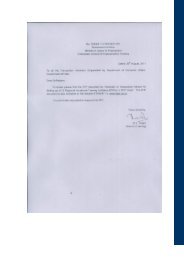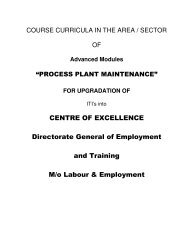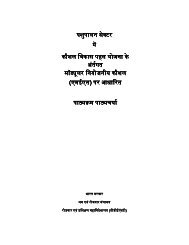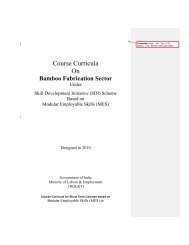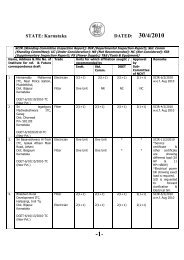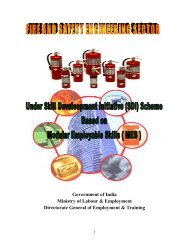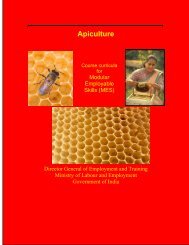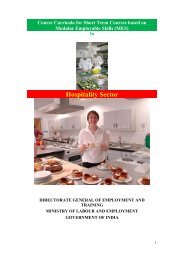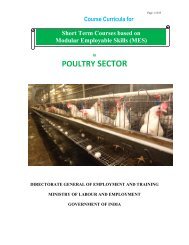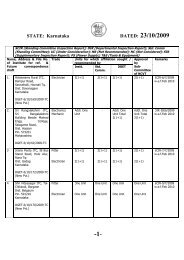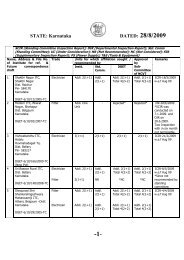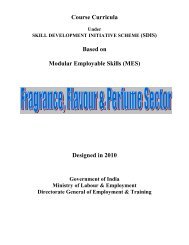Sericulture - Directorate General of Employment & Training
Sericulture - Directorate General of Employment & Training
Sericulture - Directorate General of Employment & Training
Create successful ePaper yourself
Turn your PDF publications into a flip-book with our unique Google optimized e-Paper software.
Page 74 <strong>of</strong> 87<br />
LEVEL 3<br />
1. Module Name: Mulberry Crop Protector<br />
2. Sector: <strong>Sericulture</strong><br />
3. Code: SER - 321<br />
4. Entry Qualification Minimum 5 th Standard + SER 102 + SER 213 and 17 years <strong>of</strong><br />
age.<br />
After completion <strong>of</strong> the course, the successful candidate would be<br />
able to control pests and diseases <strong>of</strong> mulberry.<br />
5. Terminal<br />
Competency:<br />
6. Duration: 200 hours<br />
7. Preface: Mulberry is prone to be infected by number <strong>of</strong> pests and diseases<br />
through out the year. The main diseases are Leaf spot, Leaf rust,<br />
Powdery mildew, Bacterial blight, Root rot and Root knot. Pests<br />
like Mealy bugs, Leaf roller, Bihar hairy caterpillar, Jassids and<br />
Thrips also affect mulberry. In addition to 20 - 30% leaf yield<br />
loss, the leaf quality is also adversely affected which in turn<br />
affects the silkworm growth and development, quality <strong>of</strong> silk and<br />
productivity leading to economic loss. Therefore, plant protection<br />
is an important component in mulberry cultivation.<br />
8. Job Pr<strong>of</strong>ile: Employable in sericulture farms and can also take up consultancy<br />
in mulberry crop protection (Seri clinic).<br />
9. Course Content:<br />
Practical competencies Under pinning knowledge (Theory)<br />
Identification <strong>of</strong> diseases and pests affecting Impact <strong>of</strong> diseases and pests on<br />
mulberry.<br />
mulberry.<br />
Observing the symptoms <strong>of</strong> diseases and pests.<br />
Calculating the percentage incidence <strong>of</strong><br />
diseases/ pests to take up plant protection<br />
measures.<br />
Practicing the control <strong>of</strong> diseases and pests by<br />
field sanitation, soil solarisation, manuring,<br />
flooding, mulching, intercropping, weeding<br />
and application <strong>of</strong> oil cakes.<br />
Practicing the control <strong>of</strong> diseases and pests by<br />
using fungicides/ pesticides – Types <strong>of</strong><br />
fungicides and pesticides, calculation <strong>of</strong><br />
concentration and dosage, preparation <strong>of</strong><br />
working solutions, method <strong>of</strong> spraying,<br />
precaution during spraying, handling <strong>of</strong><br />
sprayers and maintenance, residual toxicity <strong>of</strong><br />
pesticides, safe period, use <strong>of</strong> antidote and safe<br />
<strong>General</strong> account on diseases and<br />
pests and their symptoms.<br />
Life cycle <strong>of</strong> important diseases and<br />
pests.<br />
Mode <strong>of</strong> diseases and pests<br />
transmission.<br />
Influence <strong>of</strong> environmental factors on<br />
diseases and pests out break.



